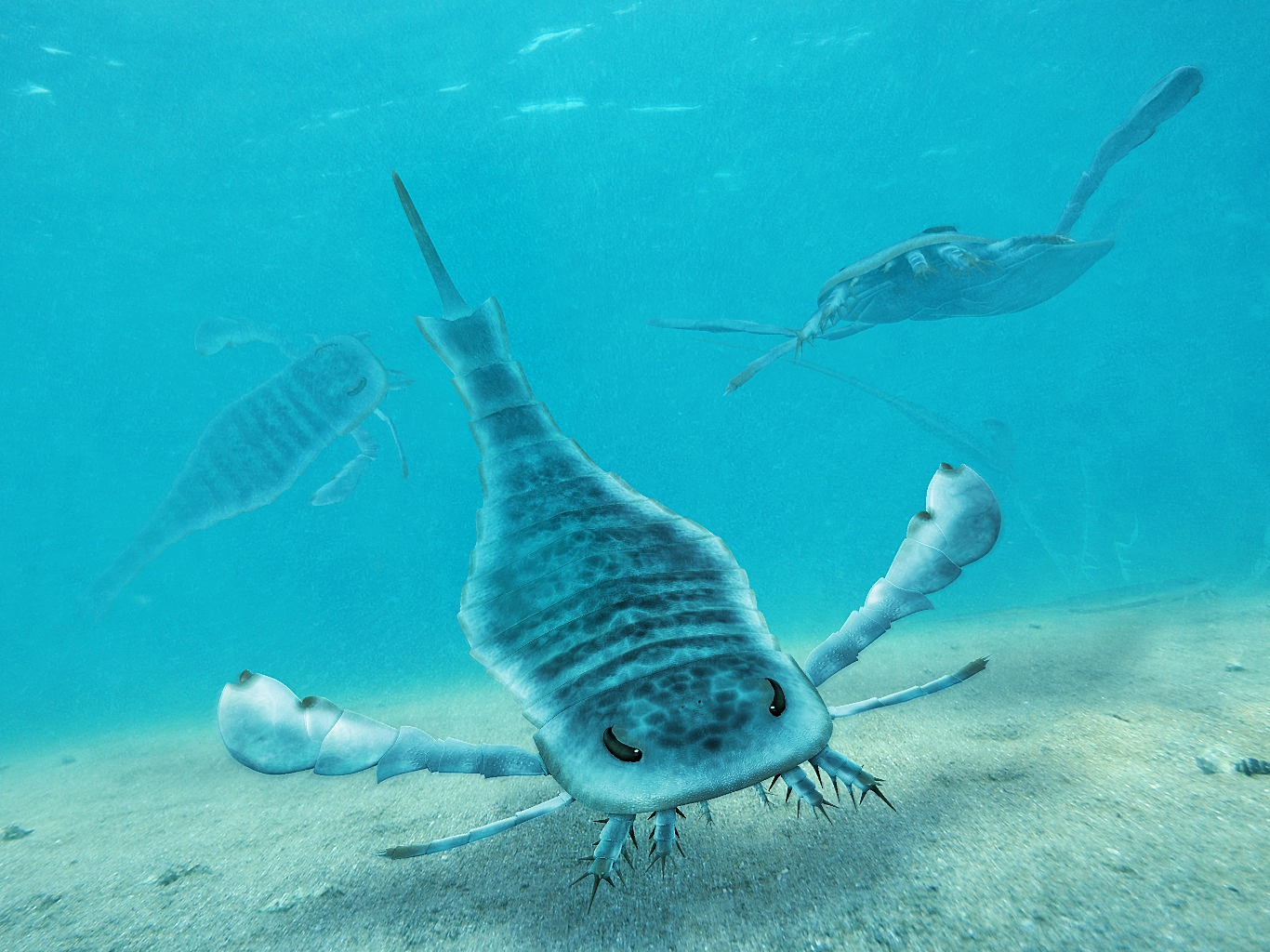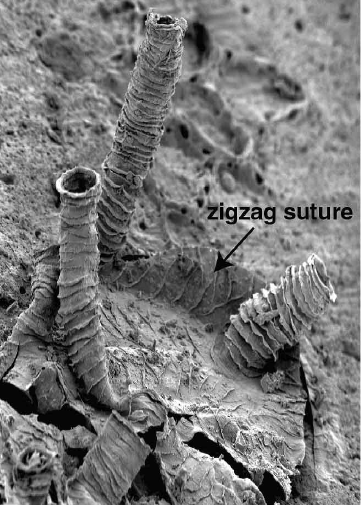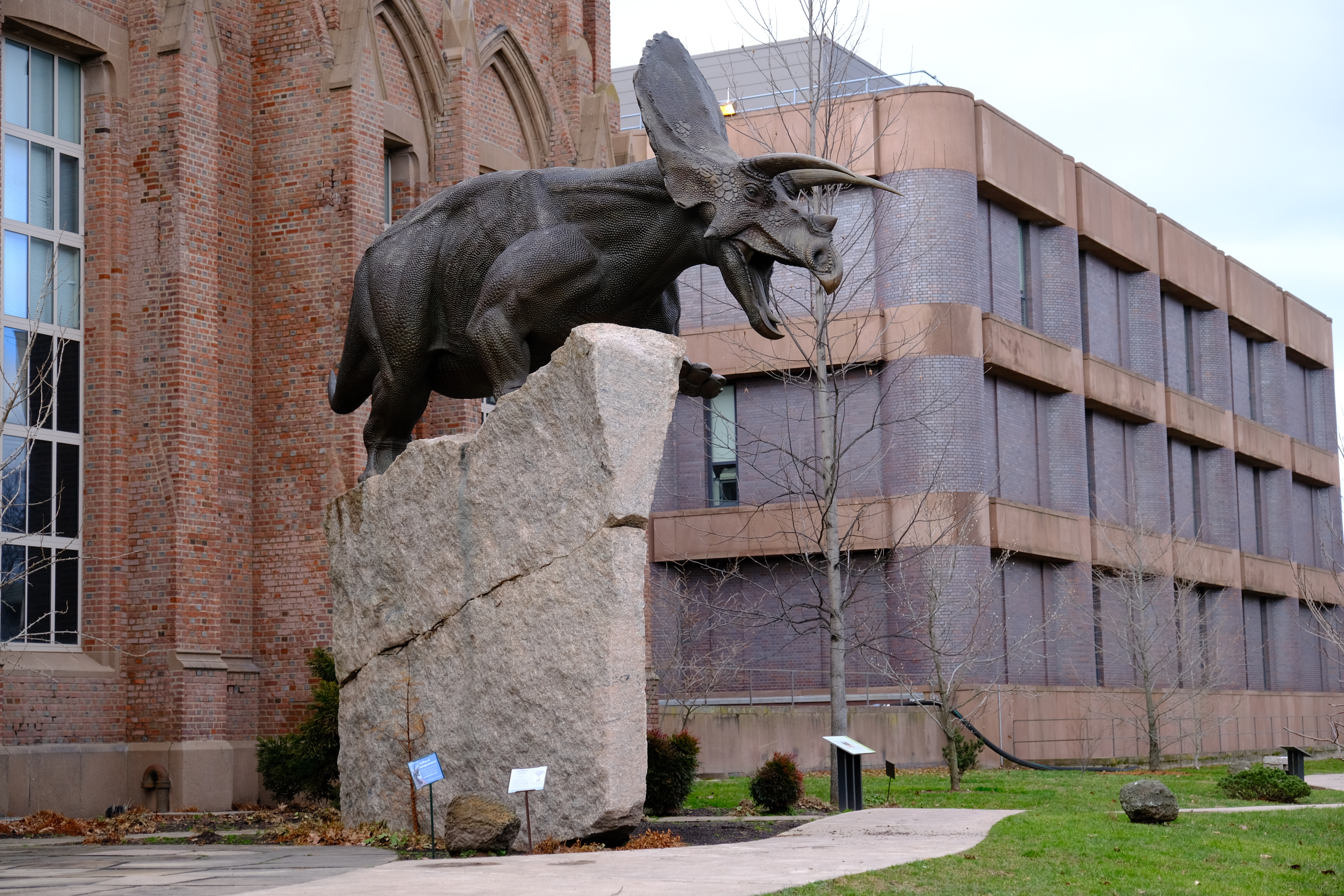|
Rotaciurca
''Rotaciurca'' is an extinct genus of Silurian cephalodiscid pterobranchs. The genus contains a single species, ''Rotaciurca superbus'', known from the Bertie Group of Ontario, Canada. Description ''Rotaciurca'' is a pseudocolonial (containing multiple clustered individuals which are not connected) pterobranch, unique for being a cephalodiscid rather than a graptolite. The cluster consists of a ring of radiating tubes, likely containing the living individuals, attached to a conical structure interpreted as a float, giving the original fossil the nickname of "Ezekiel's wheel". The whole organism is roughly long, seemingly with two distinct rows of tubes. Its pterobranch affinity is confirmed by lineations within the tubes, which are traces of fuselli, and the irregular arrangement of these group it with the cephalodiscids. ''Rotaciurca'' has a number of similarities to '' Yuknessia'', another enigmatic fossil recently described as a pterobranch, including rigid and similarly ... [...More Info...] [...Related Items...] OR: [Wikipedia] [Google] [Baidu] |
Bertie Group
The Bertie Group or Bertie Limestone, also referred to as the Bertie Dolomite and the Bertie Formation, is an upper Silurian ( Pridoli, or Cayugan) geologic group and Lagerstätte in southern Ontario, Canada, and western New York State, United States. Details of the type locality and of stratigraphic nomenclature for this unit as used by the U.S. Geological Survey are available on-line at the National Geologic Map Database. The formation comprises dolomites, limestones and shales and reaches a thickness of in the subsurface, while in outcrop the group can be thick. The group represents the uppermost unit of the Cayugan Series and the youngest Silurian unit in Ontario. The group overlies the Salina Group and is conformably overlain by the Devonian Bois Blanc Formation in Ontario and Onondaga Limestone in New York. Two formations within the Bertie Group, the Fiddler's Green and Williamsville, are considered Konservat-Lagerstätten; geologic units that contain a unique and ty ... [...More Info...] [...Related Items...] OR: [Wikipedia] [Google] [Baidu] |
Cephalodiscida
Cephalodiscida is one of two orders in the class Pterobranchia, which are small, worm-shaped animals. Members belong to the hemichordata, hemichordates. Species in this order are Sessility (zoology), sessile, living in clear water and secretion, secrete tubes on the ocean floor. Taxonomy The order is a small one, with only two known families, each containing a single extant genus. The validity of the family Atubaridae, who has only a sole member, is regarded as questionable. * Order Cephalodiscida Fowler 1892 ** Family Cephalodiscidae Harmer 1905 *** Genus †''Aellograptus'' Obut 1964 *** Genus †''Eocephalodiscus'' Kozlowski 1938 ex Kozlowski 1949 *** Genus †''Melanostrophus'' Öpik 1930 ex Öpik 1933 *** Genus †''Pterobranchites'' Kozlowski 1967 *** Genus ''Atubaria'' Sato 1936 *** Genus ''Cephalodiscus'' M'Intosh 1882 ** Family †Rotaciurcidae Briggs and Koch 2023 *** Genus †''Rotaciurca'' Briggs and Koch 2023 References Harmer. S. F. 1905. The Pterobranchia ol ... [...More Info...] [...Related Items...] OR: [Wikipedia] [Google] [Baidu] |
Pridoli Epoch
In the geologic timescale, the Přídolí Epoch () is the uppermost subdivision of the Silurian Period, dated at between 423 ± 2.3 and 419.2 ± 3.2 mya (million years ago). The Přídolí Epoch succeeds the Ludfordian Stage and precedes the Lochkovian, the lowest of three stages within the Lower Devonian geological epoch. It is named after one locality at the ''Homolka a Přídolí'' nature reserve near the Prague suburb, Slivenec, in the Czech Republic. The GSSP is located within the Požáry Formation, overlying the Kopanina Formation. Přídolí is the old name of a cadastral field area. The Šilalė Event, a negative carbon isotope excursion corresponding to an extinction event of Conodont, conodonts, occurred during the early Pridoli. References Pridoli epoch, Silurian geochronology Geological epochs {{Geochronology-stub ... [...More Info...] [...Related Items...] OR: [Wikipedia] [Google] [Baidu] |
Silurian
The Silurian ( ) is a geologic period and system spanning 23.5 million years from the end of the Ordovician Period, at million years ago ( Mya), to the beginning of the Devonian Period, Mya. The Silurian is the third and shortest period of the Paleozoic Era, and the third of twelve periods of the Phanerozoic Eon. As with other geologic periods, the rock beds that define the period's start and end are well identified, but the exact dates are uncertain by a few million years. The base of the Silurian is set at a series of major Ordovician–Silurian extinction events when up to 60% of marine genera were wiped out. One important event in this period was the initial establishment of terrestrial life in what is known as the Silurian-Devonian Terrestrial Revolution: vascular plants emerged from more primitive land plants, dikaryan fungi started expanding and diversifying along with glomeromycotan fungi, and three groups of arthropods ( myriapods, arachnids and hexapods) ... [...More Info...] [...Related Items...] OR: [Wikipedia] [Google] [Baidu] |
Monotypic Taxon
In biology, a monotypic taxon is a taxonomic group (taxon) that contains only one immediately subordinate taxon. A monotypic species is one that does not include subspecies or smaller, infraspecific taxa. In the case of Genus, genera, the term "unispecific" or "monospecific" is sometimes preferred. In botanical nomenclature, a monotypic genus is a genus in the special case where a genus and a single species are simultaneously described. Theoretical implications Monotypic taxa present several important theoretical challenges in biological classification. One key issue is known as "Gregg's Paradox": if a single species is the only member of multiple hierarchical levels (for example, being the only species in its genus, which is the only genus in its family), then each level needs a distinct definition to maintain logical structure. Otherwise, the different taxonomic ranks become effectively identical, which creates problems for organizing biological diversity in a hierarchical o ... [...More Info...] [...Related Items...] OR: [Wikipedia] [Google] [Baidu] |
Ontario
Ontario is the southernmost Provinces and territories of Canada, province of Canada. Located in Central Canada, Ontario is the Population of Canada by province and territory, country's most populous province. As of the 2021 Canadian census, it is home to 38.5% of the country's population, and is the second-largest province by total area (after Quebec). Ontario is Canada's fourth-largest jurisdiction in total area of all the Canadian provinces and territories. It is home to the nation's capital, Ottawa, and its list of the largest municipalities in Canada by population, most populous city, Toronto, which is Ontario's provincial capital. Ontario is bordered by the province of Manitoba to the west, Hudson Bay and James Bay to the north, and Quebec to the east and northeast. To the south, it is bordered by the U.S. states of (from west to east) Minnesota, Michigan, Ohio, Pennsylvania, and New York (state), New York. Almost all of Ontario's border with the United States follows riv ... [...More Info...] [...Related Items...] OR: [Wikipedia] [Google] [Baidu] |
Graptolite
Graptolites are a group of colonial animals, members of the subclass Graptolithina within the class Pterobranchia. These filter-feeding organisms are known chiefly from fossils found from the Middle Cambrian ( Miaolingian, Wuliuan) through the Lower Carboniferous ( Mississippian). A possible early graptolite, ''Chaunograptus'', is known from the Middle Cambrian. Recent analyses have favored the idea that the living pterobranch '' Rhabdopleura'' represents an extant graptolite which diverged from the rest of the group in the Cambrian. Fossil graptolites and ''Rhabdopleura'' share a colony structure of interconnected zooids housed in organic tubes (theca) which have a basic structure of stacked half-rings (fuselli). Most extinct graptolites belong to two major orders: the bush-like sessile Dendroidea and the planktonic, free-floating Graptoloidea. These orders most likely evolved from encrusting pterobranchs similar to ''Rhabdopleura''. Due to their widespread abundance, pl ... [...More Info...] [...Related Items...] OR: [Wikipedia] [Google] [Baidu] |
Ezekiel
Ezekiel, also spelled Ezechiel (; ; ), was an Israelite priest. The Book of Ezekiel, relating his visions and acts, is named after him. The Abrahamic religions acknowledge Ezekiel as a prophet. According to the narrative, Ezekiel prophesied the destruction of Judah's capital city Jerusalem. In 587 BC, the Neo-Babylonian Empire conquered Jerusalem, destroyed Solomon's Temple, and sent the Judahite upper classes into the Babylonian captivity. However, Ezekiel also prophesied the eventual restoration of the Jewish people to the Land of Israel. It is believed he died around 570 BC; Ezekiel's Tomb is a Jewish religious site in Mesopotamia. Three decades later, in 539 BC, the Persian empire conquered Babylon and the Edict of Cyrus repatriated the exiles. The name "Ezekiel" means "God is strong" or "God strengthens" in Hebrew. Biblical account The author of the Book of Ezekiel presents himself as Ezekiel, the son of Buzi, born into a priestly ( kohen) lineage. The aut ... [...More Info...] [...Related Items...] OR: [Wikipedia] [Google] [Baidu] |
Yuknessia
''Yuknessia'' is an early pterobranch, known from the Burgess shale, the Chengjiang and the Wheeler shale. Long, unbranched fronds emerge from a central holdfast-like body covered in small conical plates. 23 specimens of ''Yuknessia'' are known from the Greater Phyllopod bed, where they comprise < 0.1% of the community. The genus contains two species: the type species ''Y. simplex'' and ''Y. stephenensis''. It was originally interpreted as a , and has since been reinterpreted it as a colonial pterobranch. References External links [...More Info...] [...Related Items...] OR: [Wikipedia] [Google] [Baidu] |
Portuguese Man O' War
The Portuguese war (''Physalia physalis''), also known as the man-of-war or bluebottle, is a marine hydrozoan found in the Atlantic Ocean and the Indian Ocean. It is the only species in the genus ''Physalia'', which in turn is the only genus in the family Physaliidae. The name ''man o’ war'' comes from the man-of-war, a sailing warship, and the animal's resemblance to the Portuguese version (the caravel) at full sail. The man o' war are part of the neuston, organisms that live on the surface of the water. A gas-filled bladder provides buoyancy that lets the animal stay afloat on the surface of the water while tentacles which can be up to165 ft (9 to 50 m) long hang below the surface, containing venomous Cnidocyte, cnidocytes that help capture prey. The cnidocytes can deliver a sting powerful enough to kill fish, and even, in some cases, humans. A sail on the bladder, which may be left or right-handed, propels it about the sea, often in groups. Although it superficially resembl ... [...More Info...] [...Related Items...] OR: [Wikipedia] [Google] [Baidu] |
Hemichordata
Hemichordata ( ) is a phylum which consists of triploblastic, eucoelomate, and bilaterally symmetrical marine deuterostome animals, generally considered the sister group of the echinoderms. They appear in the Lower or Middle Cambrian and include two main classes: Enteropneusta (acorn worms), and Pterobranchia. A third class, Planctosphaeroidea, is known only from the larva of a single species, '' Planctosphaera pelagica''. The class Graptolithina, formerly considered extinct, is now placed within the pterobranchs, represented by a single living genus '' Rhabdopleura''. Acorn worms are solitary worm-shaped organisms. They generally live in burrows (the earliest secreted tubes) and are deposit feeders, but some species are pharyngeal filter feeders, while the family are free living detritivores. Many are well known for their production and accumulation of various halogenated phenols and pyrroles. Pterobranchs are filter-feeders, mostly colonial, living in a collagenous ... [...More Info...] [...Related Items...] OR: [Wikipedia] [Google] [Baidu] |
Yale Peabody Museum
The Peabody Museum of Natural History at Yale University (also known as the Yale Peabody Museum of Natural History or the Yale Peabody Museum) is one of the oldest, largest, and most prolific university natural history museums in the world. It was founded by the philanthropist George Peabody in 1866 at the behest of his nephew Othniel Charles Marsh, an early paleontologist. The museum is best known for the Great Hall of Dinosaurs, which includes a mounted juvenile ''Brontosaurus'' and the mural '' The Age of Reptiles''. The museum also has permanent exhibits dedicated to human and mammal evolution; wildlife dioramas; Egyptian artifacts; local birds and minerals; and Native Americans of Connecticut. In 2020, the Peabody Museum closed for its "first comprehensive renovation in 90 years." It reopened, with more than twice the exhibition space, on March 26, 2024. Description The Peabody Museum is located at 170 Whitney Avenue in New Haven, Connecticut and is staffed by nearly ... [...More Info...] [...Related Items...] OR: [Wikipedia] [Google] [Baidu] |






